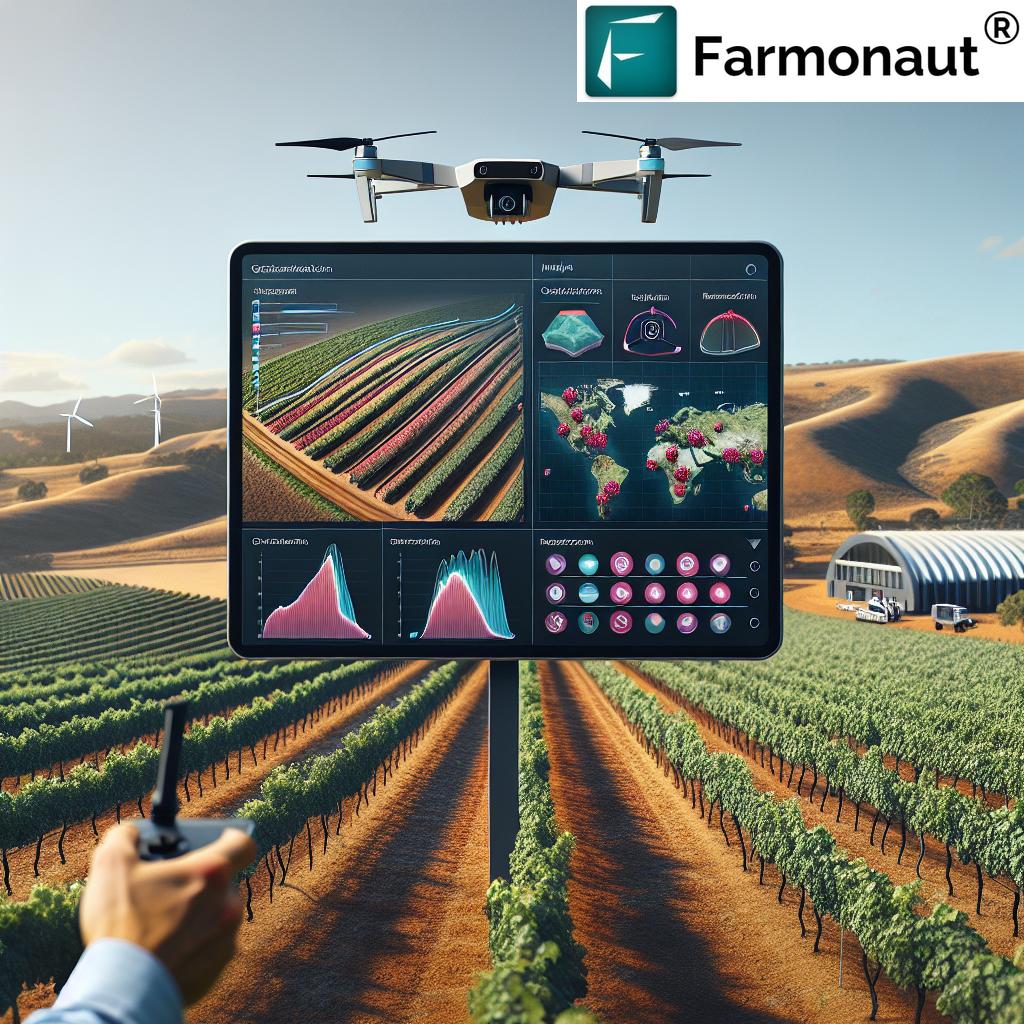Revolutionizing Australian Wine Exports: GIS-Powered Insights for Sustainable Vineyard Management and Global Market Success

“Australian wine exports reached 615 million liters in 2021, with China previously being the largest market at 39% of total value.”
Welcome to our comprehensive guide on revolutionizing Australian wine exports through GIS-powered insights and sustainable vineyard management practices. In this blog post, we’ll explore the dynamic world of the Australian wine industry and how cutting-edge technologies are reshaping the global wine market landscape. From navigating complex wine labelling regulations to uncovering emerging markets in Asia, Europe, and the Americas, we’ll provide valuable information for wine industry professionals looking to elevate their export strategies and vineyard management techniques.
The Australian Wine Industry: A Global Powerhouse
Australia has long been recognized as a major player in the global wine market. Our unique terroir, innovative winemaking practices, and commitment to quality have positioned Australian wines as sought-after products worldwide. However, the industry faces ongoing challenges, including climate change, shifting consumer preferences, and evolving international trade dynamics.
To maintain our competitive edge, we must embrace new technologies and sustainable practices that can help us navigate these challenges while enhancing the quality and marketability of our wines. This is where Geographic Information Systems (GIS) and other innovative agtech solutions come into play, offering unprecedented insights into vineyard management and export opportunities.
GIS: A Game-Changer for Vineyard Management
Geographic Information Systems (GIS) have emerged as a powerful tool for vineyard managers and winemakers. By integrating spatial data with other key metrics, GIS provides a comprehensive view of vineyard conditions, enabling more informed decision-making and precise management practices.
- Soil Analysis: GIS can map soil types, nutrient levels, and drainage patterns across a vineyard, allowing for targeted fertilization and irrigation strategies.
- Climate Monitoring: By overlaying climate data with vineyard maps, managers can better understand microclimates within their properties and make informed decisions about grape variety selection and planting locations.
- Pest and Disease Management: GIS helps track the spread of pests and diseases, enabling early intervention and more effective control measures.
- Yield Prediction: By analyzing historical data and current conditions, GIS can provide more accurate yield predictions, helping with harvest planning and marketing strategies.
One company at the forefront of this technological revolution is Farmonaut, offering advanced satellite-based farm management solutions that integrate seamlessly with GIS applications.
Farmonaut: Empowering Australian Vineyards with Satellite Technology
Farmonaut’s innovative platform leverages satellite imagery and artificial intelligence to provide real-time insights into crop health, soil moisture levels, and other critical metrics. For Australian vineyard managers, this means access to valuable data that can inform decisions about irrigation, fertilizer usage, and pest management, ultimately optimizing grape yields and quality.
Key features of Farmonaut’s technology that benefit Australian vineyards include:
- Satellite-Based Crop Health Monitoring: Regular updates on vegetation health indices like NDVI (Normalized Difference Vegetation Index) help vineyard managers identify areas of stress or potential issues before they become visible to the naked eye.
- AI-Powered Advisory System: Farmonaut’s Jeevn AI analyzes satellite data and other inputs to provide personalized recommendations for crop management, helping vineyard managers make data-driven decisions.
- Resource Management Tools: Efficient management of water resources and other inputs is crucial for sustainable winegrowing. Farmonaut’s platform helps optimize resource allocation, reducing waste and improving overall vineyard sustainability.
By integrating Farmonaut’s technology with existing GIS systems, Australian vineyards can gain a competitive edge in both vineyard management and wine production.
Sustainable Winegrowing: A Priority for Australian Vineyards
Sustainability has become a key focus for the Australian wine industry, driven by both environmental concerns and consumer demand for eco-friendly products. GIS and satellite technology play a crucial role in implementing and monitoring sustainable practices across vineyards.
- Water Conservation: GIS-powered irrigation management systems help vineyards optimize water usage, crucial in Australia’s often drought-prone regions.
- Reduced Chemical Use: Precise mapping of pest and disease outbreaks allows for targeted treatments, minimizing the overall use of pesticides and fungicides.
- Carbon Footprint Reduction: By optimizing vineyard operations and resource use, GIS contributes to reducing the overall carbon footprint of wine production.
- Biodiversity Promotion: GIS helps in planning and maintaining biodiversity corridors within and around vineyards, supporting local ecosystems.
Initiatives like Sustainable Winegrowing Australia provide frameworks and certifications for vineyards committed to sustainable practices. By leveraging GIS and satellite technology, Australian vineyards can more effectively implement and showcase their sustainability efforts, appealing to environmentally conscious consumers in global markets.
“The global organic wine market is projected to grow at a CAGR of 10.2% from 2021 to 2026, reaching $15.5 billion.”
Navigating the Global Wine Market: Export Strategies and Insights
Success in the global wine market requires a deep understanding of international trends, consumer preferences, and regulatory environments. GIS-powered market analysis tools can provide valuable insights to help Australian wine exporters make informed decisions and tailor their strategies to specific markets.
Emerging Markets and Opportunities
While traditional markets like the United Kingdom and the United States remain important, Australian wine exporters are increasingly looking to emerging markets for growth opportunities. Some key regions to watch include:
- Asia: Countries like Japan, South Korea, and Southeast Asian nations (Indonesia, Thailand, Vietnam) show growing appreciation for Australian wines.
- Europe: Beyond the UK, markets in Scandinavia and Eastern Europe offer potential for premium Australian wines.
- Americas: Canada and Latin American countries present opportunities for diversification beyond the US market.
GIS-based market analysis can help identify consumer clusters, track sales trends, and optimize distribution strategies in these diverse markets.
Navigating Regulatory Challenges
Each export market comes with its own set of regulations and requirements. GIS can assist in managing the complex landscape of international wine regulations by:
- Tracking and visualizing changes in labelling requirements across different markets
- Managing geographical indications and appellations to ensure compliance and protect wine integrity
- Optimizing logistics and shipping routes to meet varying import regulations and minimize costs
Farmonaut’s API can be integrated into existing export management systems to provide real-time data on vineyard conditions, helping exporters make informed decisions about wine quality and production volumes for different markets.
| Vineyard Management Aspect | Traditional Methods | With Farmonaut Satellite System | Estimated Improvement |
|---|---|---|---|
| Water Management | Weekly manual inspections | Daily satellite-based moisture analysis | 30% water savings |
| Pest Detection | Periodic visual inspections | AI-powered early detection from satellite imagery | 50% reduction in crop losses |
| Yield Prediction | Historical data and manual estimation | AI-driven analysis of satellite data and historical trends | 20% increase in accuracy |
| Sustainability Monitoring | Annual assessments | Continuous monitoring of environmental indicators | 25% improvement in sustainability metrics |
Wine Tourism: Leveraging GIS for Enhanced Experiences
Wine tourism is an increasingly important component of the Australian wine industry, offering opportunities to build brand loyalty and create additional revenue streams. GIS technology can enhance wine tourism experiences by:
- Creating interactive maps of wine regions and vineyards for tourists
- Developing augmented reality experiences that showcase the terroir and winemaking process
- Optimizing tour routes and managing visitor flow to ensure sustainable tourism practices
By integrating GIS data with tourism initiatives, Australian wineries can offer unique, immersive experiences that set them apart in the global wine tourism market.
The Future of Australian Wine Exports: Innovation and Sustainability
As we look to the future, the Australian wine industry is well-positioned to maintain its status as a global leader through a commitment to innovation and sustainability. The integration of GIS and satellite technology, exemplified by platforms like Farmonaut, will play a crucial role in this evolution.
Key areas of focus for the future include:
- Climate Change Adaptation: Using GIS to model and prepare for the impacts of climate change on wine regions
- Precision Viticulture: Further refinement of vineyard management practices through advanced data analytics and AI
- Blockchain for Traceability: Implementing blockchain technology to enhance supply chain transparency and wine authenticity
- Sustainable Packaging: Developing eco-friendly packaging solutions to reduce the industry’s environmental footprint
By embracing these innovations and continuing to leverage GIS-powered insights, Australian wine exporters can ensure their products remain competitive and desirable in the global marketplace.
Conclusion: Embracing Technology for Global Wine Market Success
The Australian wine industry stands at the cusp of a technological revolution that promises to enhance every aspect of wine production and export. From vineyard management to market analysis and sustainable practices, GIS-powered insights are transforming how we approach the global wine market.
By leveraging innovative solutions like Farmonaut’s satellite-based management systems, Australian wine producers and exporters can:
- Optimize vineyard operations for improved quality and sustainability
- Navigate complex international markets with data-driven strategies
- Enhance wine tourism experiences through interactive, GIS-powered tools
- Adapt to climate change and evolving consumer preferences with agility
As we continue to innovate and adapt, the future of Australian wine exports looks bright, promising continued success in the competitive global wine market.
FAQs
- How does GIS technology improve vineyard management?
GIS technology enhances vineyard management by providing detailed spatial analysis of soil conditions, climate patterns, and crop health, enabling more precise and efficient farming practices. - What are the key benefits of using Farmonaut’s satellite technology for wine production?
Farmonaut’s technology offers real-time crop health monitoring, AI-powered advisory services, and resource management tools, leading to optimized yields, reduced input costs, and improved wine quality. - How can Australian wine exporters leverage GIS for market insights?
GIS can analyze global market trends, consumer preferences, and regulatory landscapes, helping exporters identify new opportunities and tailor their strategies to specific markets. - What role does sustainability play in the future of Australian wine exports?
Sustainability is increasingly important for consumer preference and regulatory compliance. GIS and satellite technology help implement and monitor sustainable practices, enhancing the appeal of Australian wines in global markets. - How can wine tourism benefit from GIS technology?
GIS can create interactive maps, optimize tour routes, and develop augmented reality experiences, enhancing the overall wine tourism experience and attracting more visitors to Australian wine regions.





